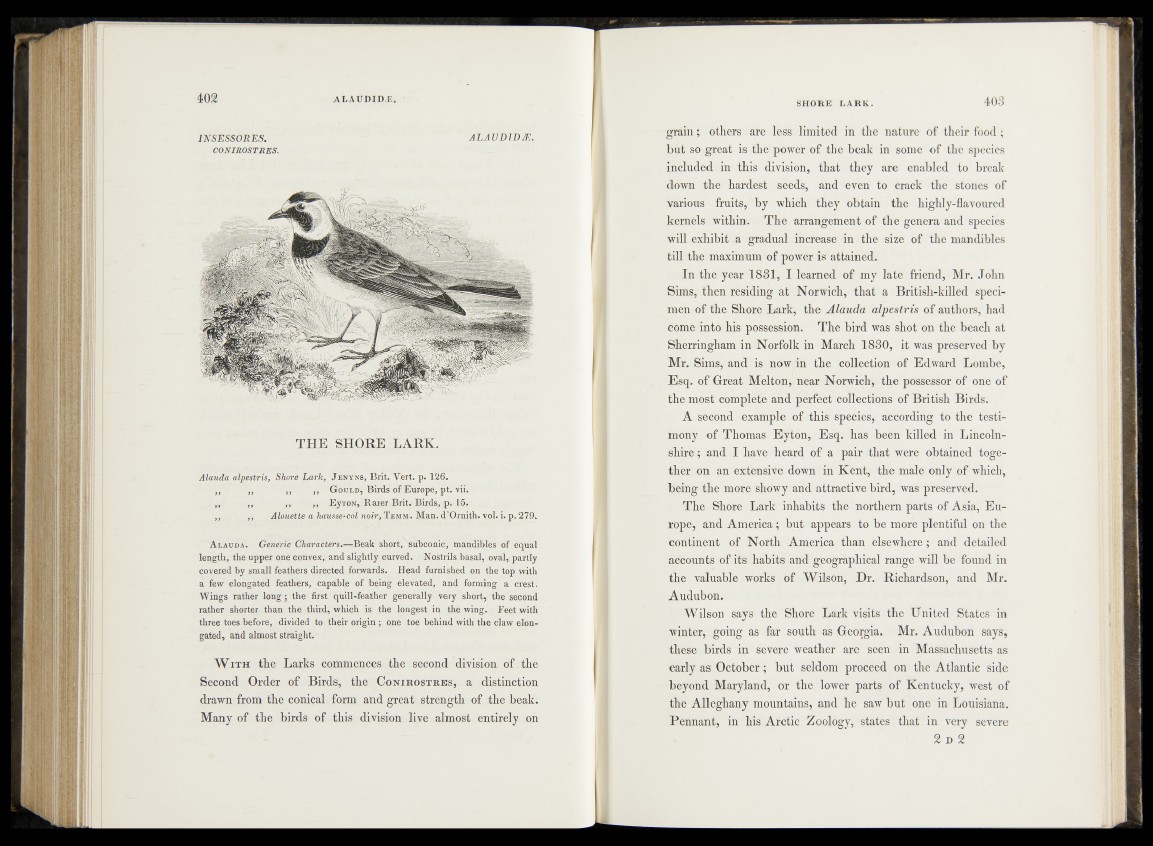
INSESSORES. ALAZJDTD/E.
CONIROSTRES.
TH E SHORE LARK.
Alauda alpestris, Shore Lark, J enyns, Brit. Vert. p. 126.
h ,, ,, ,, Gould, Birds of Europe, pt. vii.
,, ,, ,, ,, EyTON, Rarer Brit. Birds, p. 15.
,, ,, Alouette a hausse-col noir, T emm. Man. d’Ornith. vol. i. p. 279.
A lauda. Generic Characters.—Beak short, subconic, mandibles of equal
length, the upper one convex, and slightly curved. Nostrils basal, oval, partly
covered by small feathers directed forwards. Head furnished on the top with
a few elongated feathers, capable of being elevated, and forming a crest.
Wings rather long; the first quill-feather generally very short, the second
rather shorter than the third, which is the longest in the wing. Eeet with
three toes before, divided to their origin ; one toe behind with the claw elongated,
and almost straight.
W i t h the Larks commences the second division of the
Second Order of Birds, the C o n ir o s t r e s , a distinction
drawn from the conical form and great strength of the beak.
Many of the birds of this division live almost entirely on
grain; others are less limited in the nature of their food ;
but so great is the power of the beak in some of the species
included in this division, that they are enabled to break
down the hardest seeds, and even to crack the stones of
various fruits, by which they obtain the highly-flavoured
kernels within. The arrangement of the genera and species
will exhibit a gradual increase in the size of the mandibles
till the maximum of power is attained.
In the year 1831, I learned of my late friend, Mr. John
Sims, then residing at Norwich, that a British-killed specimen
of the Shore Lark, the Alauda alpestris of authors, had
come into his possession. The bird was shot on the beach at
Sherringham in Norfolk in March 1830, it was preserved by
Mr. Sims, and is now in the collection of Edward Lombe,
Esq. of Great Melton, near Norwich, the possessor of one of
the most complete and perfect collections of British Birds.
A second example of this species, according to the testimony
of Thomas Eyton, Esq. has been killed in Lincolnshire
; and I have heard of a pair that were obtained together
on an extensive down in Kent, the male only of which,
being the more showy and attractive bird, was preserved.
The Shore Lark inhabits the northern parts of Asia, Europe,
and America; but appears to be more plentiful on the
continent of North America than elsewhere; and detailed
accounts of its habits and geographical range will be found in
the valuable works of Wilson, Dr. Richardson, and Mr.
Audubon.
Wilson says the Shore Lark visits the United States in
winter, going as far south as Georgia. Mr. Audubon says,
these birds in severe weather are seen in Massachusetts as
early as October; but seldom proceed on the Atlantic side
beyond Maryland, or the lower parts of Kentucky, west of
the Alleghany mountains, and he saw but one in Louisiana.
Pennant, in his Arctic Zoology, states that in very severe
2 d 2